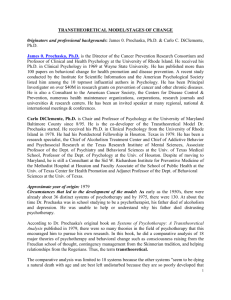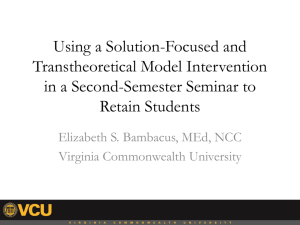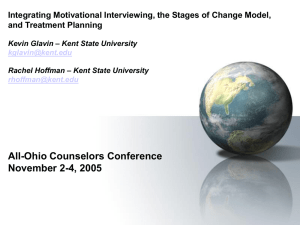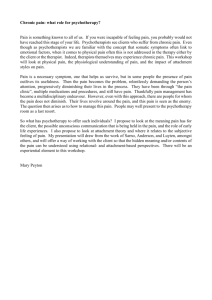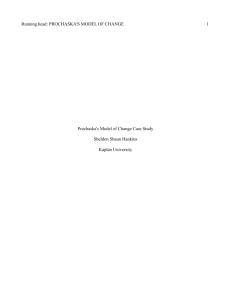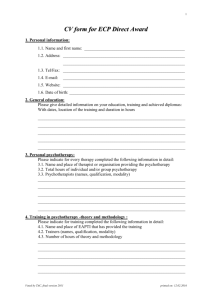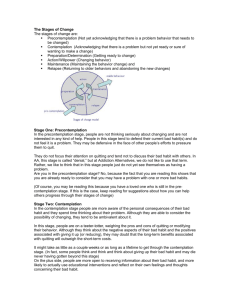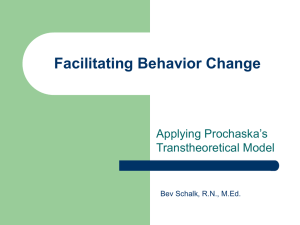Chapter 14 Integrative and Evidence
advertisement
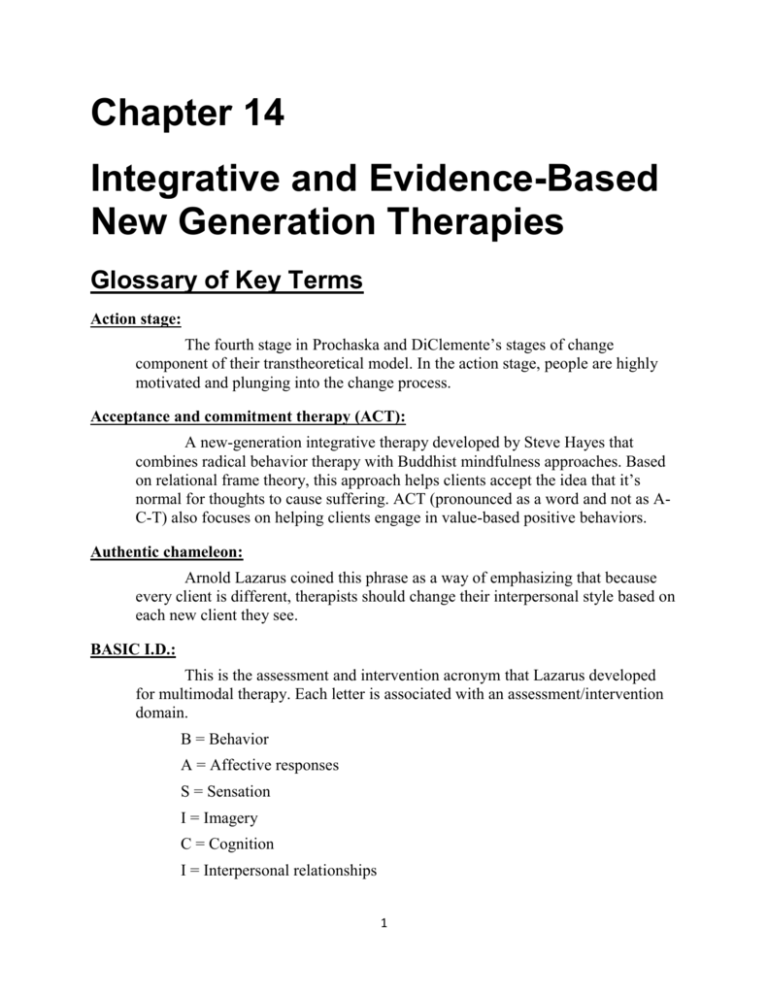
Chapter 14 Integrative and Evidence-Based New Generation Therapies Glossary of Key Terms Action stage: The fourth stage in Prochaska and DiClemente’s stages of change component of their transtheoretical model. In the action stage, people are highly motivated and plunging into the change process. Acceptance and commitment therapy (ACT): A new-generation integrative therapy developed by Steve Hayes that combines radical behavior therapy with Buddhist mindfulness approaches. Based on relational frame theory, this approach helps clients accept the idea that it’s normal for thoughts to cause suffering. ACT (pronounced as a word and not as AC-T) also focuses on helping clients engage in value-based positive behaviors. Authentic chameleon: Arnold Lazarus coined this phrase as a way of emphasizing that because every client is different, therapists should change their interpersonal style based on each new client they see. BASIC I.D.: This is the assessment and intervention acronym that Lazarus developed for multimodal therapy. Each letter is associated with an assessment/intervention domain. B = Behavior A = Affective responses S = Sensation I = Imagery C = Cognition I = Interpersonal relationships 1 D = Drugs and biology Common factors: The common factors approach to psychotherapy integration emphasizes that all forms of counseling or psychotherapy operate on the same basic or common therapy principles. Two of the most popular common factors approaches were described by Jerome Frank and Michael Lambert. Contemplation: The second stage in Prochaska and DiClemente’s stages of change component of their transtheoretical model. In the contemplative stage, the individual is aware that a problem exists, but she has not yet made a clear commitment to making a personal change. Corrective emotional experience: Alexander and French (1946) described the corrective emotional experience: “In all forms of ... psychotherapy, the basic therapeutic principle is the same: To re-expose the patient, under more favorable circumstances, to emotional situations which he could not handle in the past. The patient, in order to be helped, must undergo a corrective emotional experience suitable to repair the traumatic influence of previous experiences” (p.66). Demoralization hypothesis: Frank (1985) considered demoralization to be the primary reason why people come to counseling or psychotherapy. He defined demoralization as follows: “Demoralization occurs when, because of lack of certain skills or confusion of goals, an individual becomes persistently unable to master situations which both the individual and others expect him or her to handle or when the individual experiences continued distress which he or she cannot adequately explain or alleviate. Demoralization may be summed up as a feeling of subjective incompetence, coupled with distress” (Frank, 1985, p.56). Dialectical behavior therapy (DBT): DBT is a new-generation integrative therapy developed by Marsha Linehan (1993). This therapy approach integrates a person-centered or Buddhist form of unconditional positive regard (radical acceptance) with cognitive and behavioral skills training. It was originally developed to treat individuals diagnosed with borderline personality disorder. 2 Dialectical philosophy: Dialectical philosophy emphasizes that reality includes opposing forces that are constantly shifting and changing. The three-stage process through which change occurs is referred to as the dialectic. Eclecticism: Therapists who practice eclecticism will choose one technique for one client and another for a different client and even two theoretically divergent techniques for a single client without much concern for overall theoretical compatibility. This approach is generally viewed as opposed to theoretical purity. Emotional dysregulation: This symptom of having strong emotional reactions to environmental stimuli is generally associated with clients who have borderline personality disorder. Linehan (1993) views clients with borderline personality disorder as being biologically predisposed to emotional dysregulation. Emotionally-focused therapy (EFT): Emotion-focused therapy (formerly process-experiential therapy) has roots in person-centered theory and uses the Gestalt empty chair technique as a means of focusing in on and deepening emotional experiencing and expression (Greenberg, 2011). EFT is broadly classified as an empirically supported neohumanistic therapy approach. Eye movement desensitization reprocessing (EMDR): EMDR is a new-generation integrative therapy approach. It is an evidencebased treatment for trauma in adults and children and was developed by Francine Shapiro (1989). Ideological purity: This is an approach to conducting therapy that emphasizes depth (the learning and application of a single theoretical approach) over breadth. It is very appealing in a practical sense; it allows you to become a master of one approach, rather than a mediocre jack-of-all-trades. Interpersonal psychotherapy (IPT): Interpersonal psychotherapy is a new-generation integrative, short-term, and focal approach to treating depression. It emerged quickly and established itself as an efficacious therapy for depression. IPT was developed in the 1970s by the late Gerald Klerman of Harvard University and a group of associates from Yale University. It was empirically validated in the 1980s. 3 Maintenance stage: The fifth stage in Prochaska and DiClemente’s stages of change model. In the precontemplative stage, During maintenance, people continue with positive actions and deepen their commitment toward permanent change. There is continual work or action toward relapse prevention. This stage continues from 6 months to infinity, but relapse often occurs at some point during maintenance. Multimodal therapy: This is a technically eclectic form of therapy developed by A. Lazarus (1971). Precontemplation stage: The first stage in Prochaska and DiClemente’s (1982) stages of change model. In the precontemplative stage, the individual has little or no interest in changing his behavior. Preparation stage: The third stage in Prochaska and DiClemente’s (1982) stages of change model. In the preparation stage, individuals are deep into contemplation and although they’re beginning some minimal action toward change, they’re not yet into the action stage. Radical acceptance: Radical acceptance is a concept and technique associated with DBT. It involves complete acceptance of clients and their emotional condition (as in Eastern philosophy and person-centered theory). At the same time, clients are engaged in a purposeful change process to help with emotional dysregulation and environmental invalidation (Linehan, 1993). Essentially, the therapist is communicating: “I accept you as you are, and I am helping you to change.” Relational frames theory: This is the foundational theory for acceptance and commitment therapy (ACT). Stages of change: One component of Prochaska and DiClemente’s transtheoretical model. The stages of change component focuses on how clients come to and progress through therapy at differing stages of change and therefore different interventions will be more or less effective at different stages in the change process. 4 Syncretism: When therapists choose therapy techniques in a whimsical, unreasoned, or impulsive manner, it’s called syncretism. Technical eclecticism: This is the rational and research-based approach to eclecticism popularized by Arnold Lazarus. See eclecticism. Termination stage: The sixth and final stage in Prochaska and DiClemente’s (1982) stages of change component of their transtheoretical model. In the termination stage, people have 100% confidence (or self-efficacy) that they will not engage in the problem behavior again. They also report having no urges to engage in the problem behavior again. Prochaska uses a 5-year criterion of symptom liberation, plus 100% confidence, for classification into this stage. The who-how-whom question: In 1969 Gordon Paul posed the following question to his behavioral colleagues: “What treatment, by whom, is most effective for this individual with that specific problem, under which set of circumstances, and how does it come about?” (Paul, 1969, p. 44). This question is seen as a call for technical eclecticism. Therapeutic integration: Theoretical integration involves combining of two or more theoretical approaches to maximize therapeutic effectiveness. Transtheoretical change model: The transtheoretical model is a higher-order integrational theory of psychotherapy, emphasizing both common factors and theoretical integration. It focuses on why and how people change, rather than on why people don’t change. 5
